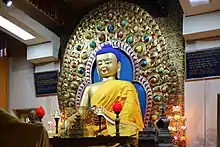Namgyal Monastery
Namgyal Monastery (Tibetan: རྣམ་རྒྱལ།, Wylie: rnam rgyal ) (also often referred to as "Dalai Lama's Temple") is currently located in Mcleod Ganj, Dharamsala, India. It is the personal monastery of the 14th Dalai Lama. Another name for this temple-complex is Namgyal Tantric College.
| Part of a series on |
| Tibetan Buddhism |
|---|
 |

This monastery's key role is to assist with rituals involving the Dalai Lama of Tibet. Its main tantric practices reportedly include those of Kalachakra, Yamantaka, Chakrasamvara, Guhyasamaja, and Vajrakilaya.
Early years
Founded in either 1564 or 1565 as Phende Lekshe Ling (on the foundations of the since defunct monastery called Phende Gon) by the Third Dalai Lama Gendun Gyatso, Namgyal Monastery was renamed in honour of the female long-life deity Namgyälma in 1571.[1]
Since the completion of construction on the Potala Palace (begun by the Fifth Dalai Lama), Namgyal was traditionally housed in the red section at the top of that building in Lhasa.
Since 1959
Following the Tibetan uprising of 1959, Namgyal Monastery relocated to Dharamshala, India, where it continues, active, to this day. According to Namgyal's website, Namgyal (Dharamshala) has "nearly 200" monks (up from 55 in 1959), representing all four main Tibetan monastic lineages.
In 1992, on the advice of the present Dalai Lama, Namgyal established an American branch in Ithaca, New York, including within it the Namgyal Monastery Institute of Buddhist Studies. On 8 February 1996, the monks of Namgyal Monastery's Institute of Buddhist Studies offered their first "Blessing of Cyberspace" as part of the "Twenty-four Hours in Cyberspace" event.[2]
In 1998, Namgyal incorporated a Tibetan monastery in Bodhgaya, India, called Gendhen Phelgyeling. That monastery is now known as Namgyal (Bodhgaya), and has 45 monks.
Namgyal (Dharamsala) also manages a temple in Kushinagar (since 1967), and an elderly home in Simla (since 1992).
Whether the People's Republic of China has maintained an institution with the same name inside Tibet is unclear.
See also
- Dalai Lama lineage
- Third Dalai Lama: founder of Namgyal Monastery
- Fifth Dalai Lama: builder of the Potala
- Fourteenth Dalai Lama: current Dalai Lama
- Losang Samten: contemporary historian of Namgyal Monastery
References
- Bryant, Barry (2003) [1992]. Wheel of Time Sand Mandala: Visual Scripture of Tibetan Buddhism (2nd. ed.). Ithaca, NY: Snow Lion Publications. pp. 95, 96. ISBN 1559391871.
The name Namgyal came into use in 1571 when the king Altan Khan of Mongolia became very ill and requested that his teacher, the Third Dalai Lama, perform long-life prayers for his recovery. The Dalai Lama instructed his monks to perform the sacred long-life prayer of the goddess Namgyalma, and from that moment on, Phende Lekshe Ling was also known as Namgyal Monastery.
- Namgyal Monastery Institute of Buddhist Studies (8 February 1996). "Blessings of Cyberspace". Archived from the original on 1 December 2012. Retrieved 15 December 2012.
In the monks' view, cyberspace resembles space in general, which Tibetan Buddhists characterize more as the absence of obstructions than as a distance between two points. Also, cyberspace, like ordinary space, can be defined as something that cannot in and of itself be seen or measured, yet which can be conceptualized and used. That is, it has no inherent existence for its own part, yet it exists as a field for mental activity. Where there is an absence of obstructions, there is the potential for something to arise, the nature of which depends on the motivation of those who use it. In blessing cyberspace, the monks reasoned, they could offer prayers that the motivation of Internet users become more positive and that the benefits of using the Internet become more positive.
External links
| Wikimedia Commons has media related to Namgyal Monastery. |
- Namgyal (Dharamshala) - The home monastery in Mcleod Ganj, India
- Namgyal (Bodh Gaya) - Gendhen Phelgyeling branch in Bodh Gaya, India
- Namgyal (Ithaca) - Institute of Buddhist Studies branch in Ithaca, New York, USA